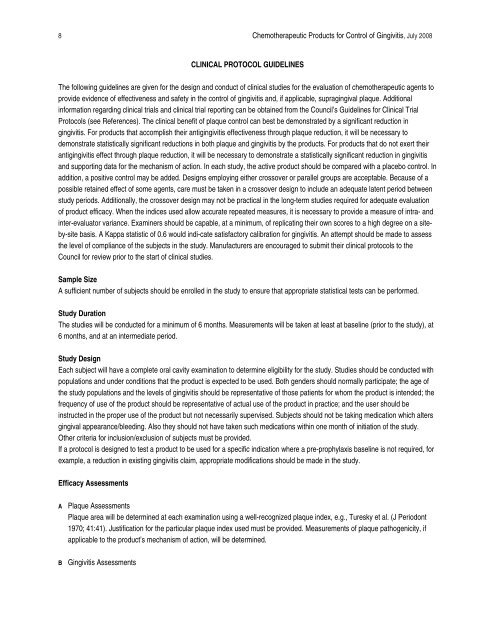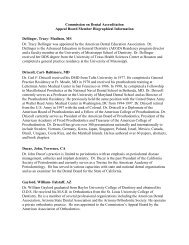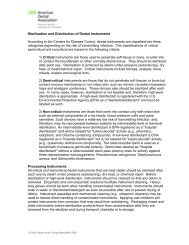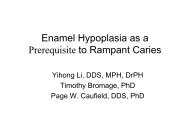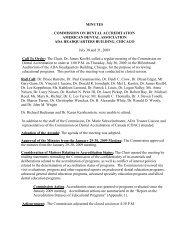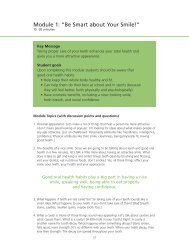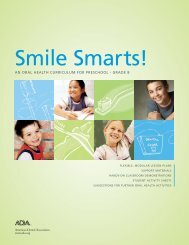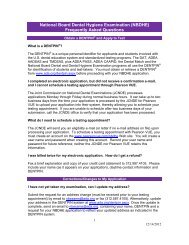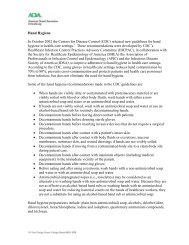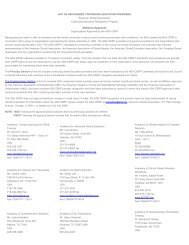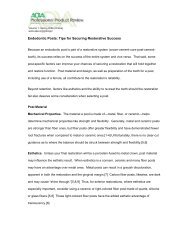Chemotherapeutic Products for the Control of Gingivitis - American ...
Chemotherapeutic Products for the Control of Gingivitis - American ...
Chemotherapeutic Products for the Control of Gingivitis - American ...
Create successful ePaper yourself
Turn your PDF publications into a flip-book with our unique Google optimized e-Paper software.
8 <strong>Chemo<strong>the</strong>rapeutic</strong> <strong>Products</strong> <strong>for</strong> <strong>Control</strong> <strong>of</strong> <strong>Gingivitis</strong>, July 2008<br />
CLINICAL PROTOCOL GUIDELINES<br />
The following guidelines are given <strong>for</strong> <strong>the</strong> design and conduct <strong>of</strong> clinical studies <strong>for</strong> <strong>the</strong> evaluation <strong>of</strong> chemo<strong>the</strong>rapeutic agents to<br />
provide evidence <strong>of</strong> effectiveness and safety in <strong>the</strong> control <strong>of</strong> gingivitis and, if applicable, supragingival plaque. Additional<br />
in<strong>for</strong>mation regarding clinical trials and clinical trial reporting can be obtained from <strong>the</strong> Council’s Guidelines <strong>for</strong> Clinical Trial<br />
Protocols (see References). The clinical benefit <strong>of</strong> plaque control can best be demonstrated by a significant reduction in<br />
gingivitis. For products that accomplish <strong>the</strong>ir antigingivitis effectiveness through plaque reduction, it will be necessary to<br />
demonstrate statistically significant reductions in both plaque and gingivitis by <strong>the</strong> products. For products that do not exert <strong>the</strong>ir<br />
antigingivitis effect through plaque reduction, it will be necessary to demonstrate a statistically significant reduction in gingivitis<br />
and supporting data <strong>for</strong> <strong>the</strong> mechanism <strong>of</strong> action. In each study, <strong>the</strong> active product should be compared with a placebo control. In<br />
addition, a positive control may be added. Designs employing ei<strong>the</strong>r crossover or parallel groups are acceptable. Because <strong>of</strong> a<br />
possible retained effect <strong>of</strong> some agents, care must be taken in a crossover design to include an adequate latent period between<br />
study periods. Additionally, <strong>the</strong> crossover design may not be practical in <strong>the</strong> long-term studies required <strong>for</strong> adequate evaluation<br />
<strong>of</strong> product efficacy. When <strong>the</strong> indices used allow accurate repeated measures, it is necessary to provide a measure <strong>of</strong> intra- and<br />
inter-evaluator variance. Examiners should be capable, at a minimum, <strong>of</strong> replicating <strong>the</strong>ir own scores to a high degree on a siteby-site<br />
basis. A Kappa statistic <strong>of</strong> 0.6 would indi-cate satisfactory calibration <strong>for</strong> gingivitis. An attempt should be made to assess<br />
<strong>the</strong> level <strong>of</strong> compliance <strong>of</strong> <strong>the</strong> subjects in <strong>the</strong> study. Manufacturers are encouraged to submit <strong>the</strong>ir clinical protocols to <strong>the</strong><br />
Council <strong>for</strong> review prior to <strong>the</strong> start <strong>of</strong> clinical studies.<br />
Sample Size<br />
A sufficient number <strong>of</strong> subjects should be enrolled in <strong>the</strong> study to ensure that appropriate statistical tests can be per<strong>for</strong>med.<br />
Study Duration<br />
The studies will be conducted <strong>for</strong> a minimum <strong>of</strong> 6 months. Measurements will be taken at least at baseline (prior to <strong>the</strong> study), at<br />
6 months, and at an intermediate period.<br />
Study Design<br />
Each subject will have a complete oral cavity examination to determine eligibility <strong>for</strong> <strong>the</strong> study. Studies should be conducted with<br />
populations and under conditions that <strong>the</strong> product is expected to be used. Both genders should normally participate; <strong>the</strong> age <strong>of</strong><br />
<strong>the</strong> study populations and <strong>the</strong> levels <strong>of</strong> gingivitis should be representative <strong>of</strong> those patients <strong>for</strong> whom <strong>the</strong> product is intended; <strong>the</strong><br />
frequency <strong>of</strong> use <strong>of</strong> <strong>the</strong> product should be representative <strong>of</strong> actual use <strong>of</strong> <strong>the</strong> product in practice; and <strong>the</strong> user should be<br />
instructed in <strong>the</strong> proper use <strong>of</strong> <strong>the</strong> product but not necessarily supervised. Subjects should not be taking medication which alters<br />
gingival appearance/bleeding. Also <strong>the</strong>y should not have taken such medications within one month <strong>of</strong> initiation <strong>of</strong> <strong>the</strong> study.<br />
O<strong>the</strong>r criteria <strong>for</strong> inclusion/exclusion <strong>of</strong> subjects must be provided.<br />
If a protocol is designed to test a product to be used <strong>for</strong> a specific indication where a pre-prophylaxis baseline is not required, <strong>for</strong><br />
example, a reduction in existing gingivitis claim, appropriate modifications should be made in <strong>the</strong> study.<br />
Efficacy Assessments<br />
A Plaque Assessments<br />
Plaque area will be determined at each examination using a well-recognized plaque index, e.g., Turesky et al. (J Periodont<br />
1970; 41:41). Justification <strong>for</strong> <strong>the</strong> particular plaque index used must be provided. Measurements <strong>of</strong> plaque pathogenicity, if<br />
applicable to <strong>the</strong> product’s mechanism <strong>of</strong> action, will be determined.<br />
B <strong>Gingivitis</strong> Assessments


